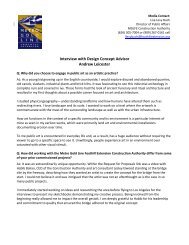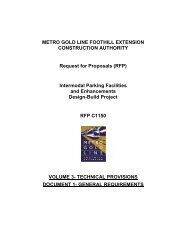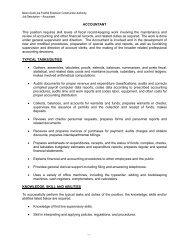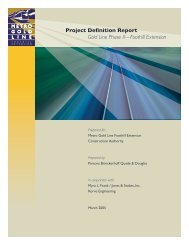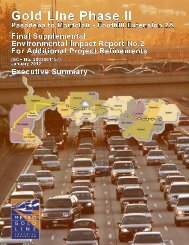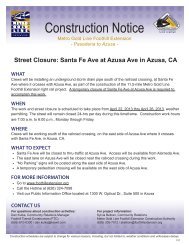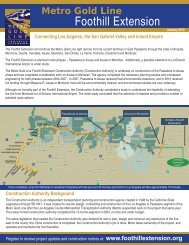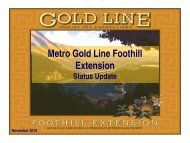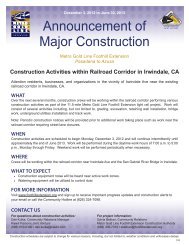Chapter 2: Proposed Bus Modifications - Metro Gold Line Foothill ...
Chapter 2: Proposed Bus Modifications - Metro Gold Line Foothill ...
Chapter 2: Proposed Bus Modifications - Metro Gold Line Foothill ...
Create successful ePaper yourself
Turn your PDF publications into a flip-book with our unique Google optimized e-Paper software.
RECOMMENDATIONS BY STATION<br />
ARCADIA STATION<br />
The Arcadia Station will be located in the downtown area on the north side of Santa Clara Street between North 1st<br />
Avenue and Santa Anita Avenue. Three bus routes currently operate in the vicinity as shown in Figure 2-2.<br />
<strong>Metro</strong> Route 79<br />
This local bus route extends from downtown Los Angeles to Arcadia and currently terminates near the proposed <strong>Gold</strong><br />
<strong>Line</strong> station site. Eastbound buses approach the station area via Huntington Drive, turn north on 2nd Avenue and west<br />
on St. Joseph Street to an on-street layover point facing west. Departing westbound trips turn south on 1st Avenue and<br />
west on Huntington returning to Los Angeles.<br />
Weekday ridership information compiled from <strong>Metro</strong> automatic passenger count (APC) data indicates that Arcadia is a<br />
signifi cant trip generator on Route 79. An average 272 riders board at six bus stops east of and including Santa Anita<br />
Avenue, which represents 6.7 percent of approximately 4,100 total average weekday daily boardings on the route.<br />
Alightings (227) represent 5.5 percent of total alightings. Minor realignment is recommended to bring Route 79 nearer to<br />
the <strong>Gold</strong> <strong>Line</strong> station entrance on Santa Clara Street and to provide a new layover point. As proposed, eastbound buses<br />
would approach via Huntington Drive, turn north on 1st Avenue and west on Santa Clara Street to a new terminal point<br />
located in a bus pullout on Santa Clara Street. Westbound departures would turn south on Santa Anita Avenue and west<br />
on Huntington Drive, returning to Los Angeles.<br />
<strong>Metro</strong> Route 487<br />
This express bus route operates<br />
between the Westlake District in Los<br />
Angeles and the El Monte <strong>Bus</strong>way<br />
Station via downtown Los Angeles<br />
and a “U”-shaped alignment passing<br />
through San Gabriel, Pasadena and<br />
Arcadia. The existing alignment<br />
serves both the existing Sierra<br />
Madre Villa Station and the planned<br />
Arcadia Station. Route 487 travels<br />
north-south on Santa Anita Avenue<br />
and passes one-half block west<br />
of the proposed Arcadia Station<br />
site. Existing northbound and<br />
southbound bus stops are located<br />
at the intersection of Santa Anita<br />
Avenue and Santa Clara Street.<br />
Ridership information compiled<br />
from <strong>Metro</strong> Automatic Passenger<br />
<strong>Foothill</strong> Extension <strong>Bus</strong> Interface Plan<br />
Passengers<br />
300<br />
250<br />
200<br />
150<br />
100<br />
50<br />
0<br />
<strong>Metro</strong> Route 487<br />
Weekday Eastbound Ridership<br />
Boardings<br />
Alightings<br />
Left on Board<br />
Figure 2-3<br />
Passengers on Board<br />
Station Vicinty<br />
SMV<br />
Arcadia<br />
1,000<br />
900<br />
800<br />
700<br />
600<br />
500<br />
400<br />
300<br />
200<br />
100<br />
0<br />
CHAPTER 2 | PROPOSED BUS ROUTE MODIFICATIONS<br />
Counter (APC) data is displayed in Figure 2-3 for weekday eastbound trips. The profi le refl ects a radial orientation with<br />
distinctly higher ridership on the western portion of the route. The highest number of accumulated passengers aboard all<br />
weekday trips (i.e., maximum load) occurs at the USC Medical Center <strong>Bus</strong>way Station (863 passengers) per day. Passenger<br />
volumes are signifi cantly lower in Pasadena and Arcadia, where the cumulative daily passenger load drops below 200<br />
passengers per day in San Gabriel and reaches a minimum load point of 103 passengers per day approaching the Sierra<br />
Madre Villa Station.<br />
A similar pattern is seen in Figure<br />
2-4 for westbound trips. <strong>Bus</strong>es<br />
depart from the El Monte <strong>Bus</strong>way<br />
Station with approximately 200<br />
passengers per day on board and<br />
the accumulated passenger load<br />
rises to 295 passengers per day as<br />
buses proceed north on Santa Anita<br />
toward Live Oak Avenue. The load<br />
declines approaching Arcadia from<br />
the south with 170 passengers per<br />
day on board at Santa Clara Avenue.<br />
It declines further along Sierra Madre<br />
Villa Avenue with 71 passengers per<br />
day alighting at the existing <strong>Gold</strong><br />
<strong>Line</strong> station. Thirty-seven passengers<br />
per day also board at the station<br />
for continuing service through<br />
San Gabriel and downtown Los<br />
Passengers<br />
250<br />
200<br />
150<br />
100<br />
50<br />
0<br />
<strong>Metro</strong> Route 487<br />
Weekday Westbound Ridership<br />
Figure 2-4<br />
Angeles via I-10. The maximum load point for westbound trips occurs at the Cal State Los Angeles <strong>Bus</strong>way Station (1,057<br />
passengers per day).<br />
These data suggest that the Sierra Madre Villa Station is an appropriate point at which to terminate Route 487 when the<br />
<strong>Gold</strong> <strong>Line</strong> Extension from Pasadena to Azusa opens in 2014. The results of a recent survey of bus riders conducted for this<br />
study reported that 72 percent of existing Route 487 riders are likely to use the <strong>Gold</strong> <strong>Line</strong> Extension and that Arcadia is the<br />
most likely point of access identifi ed by 29 percent of survey respondents, followed by Sierra Madre Villa Station preferred<br />
by 25 percent of respondents. Similarly, results from the concurrent survey of current <strong>Gold</strong> <strong>Line</strong> riders suggests that<br />
Arcadia Station will attract up to 8 percent of total a.m. peak boardings on the extended <strong>Gold</strong> <strong>Line</strong>. Many of these patrons<br />
currently transfer at Sierra Madre Villa.<br />
Station Vicinty<br />
SMV<br />
Arcadia<br />
Passengers on Board<br />
Truncation of Route 487 at the Sierra Madre Villa Station and introduction of a new local route between Sierra Madre<br />
Villa and El Monte via Arcadia is proposed as a means of enhancing intermodal access for most Arcadia as well as some<br />
Pasadena passengers. Operationally, Route 487 is a very long route requiring nearly two hours to complete a one-way<br />
trip, which is signifi cantly longer than most customers are willing to ride a bus. The proposed local route would operate<br />
within a 120-minute schedule cycle allow one-way running times of up to 52 minutes. This includes rerouting to serve<br />
the Arcadia Station directly by diverting buses from Santa Anita Avenue via Huntington Drive, 1st Avenue, and Colorado<br />
Boulevard in both directions. Schedule coordination would focus on peak direction connections at both stations.<br />
Boardings<br />
Alightings<br />
Left on Board<br />
1,200<br />
1,000<br />
800<br />
600<br />
400<br />
200<br />
0<br />
27



